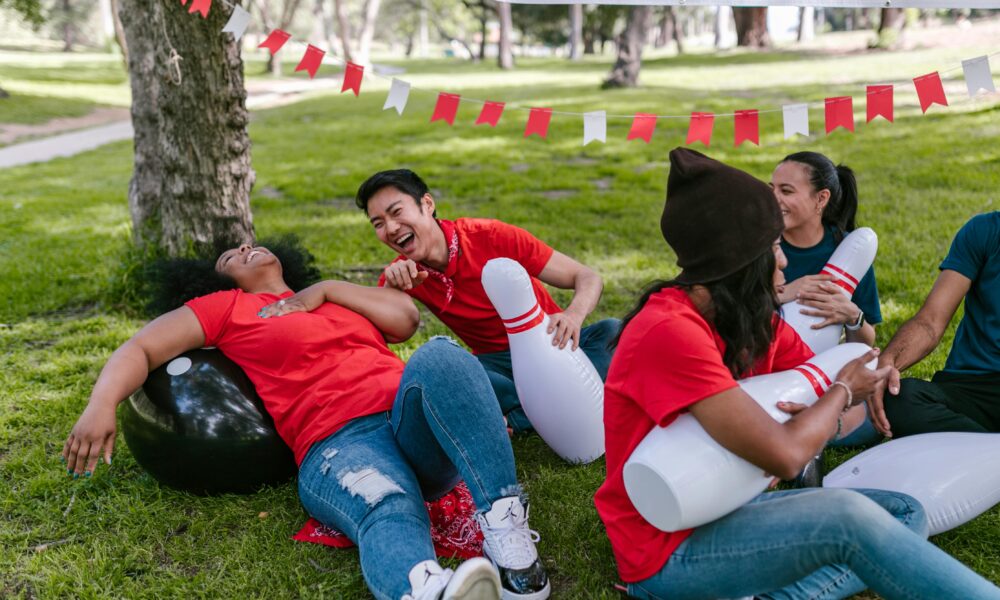How to help your team bond at an event or away day – without forcing it.
Let’s be honest: corporate team bonding has a reputation problem. The phrase alone can make people instinctively roll their eyes, recalling awkward trust falls or stilted icebreakers with forced smiles. Yet when done right, team bonding isn’t about awkward games at all, it’s about something much more powerful: creating space for people to connect on their own terms.
Events are one of the best tools we’ve got for that. Whether it’s a conference, a strategy away day, or even a half-day offsite, events create shared moments that stick – and that’s the essence of corporate team bonding.
So how do you build in corporate team bonding in events naturally, without it feeling contrived? This article breaks it down.
What is corporate team bonding, really?
Corporate team bonding is about designing shared experiences that build trust, spark conversation, and strengthen the social glue between colleagues. It’s different from team building, which tends to be more skills-focused (think problem-solving challenges or communication workshops). Team bonding is looser, more personal, and often more memorable.
When woven into events, it helps:
- Create shared experiences – Those “remember when” moments from karaoke nights, pub quizzes, escape rooms, or even spontaneous coffee runs during a conference.
- Improve communication – Time away from desks encourages people to talk more freely, understand different perspectives and build empathy.
- Strengthen relationships – Casual conversations and laughter in non-work settings build trust faster than any formal exercise.
- Foster unity – Teams feel more cohesive when they’ve seen each other as people, not just job titles.
- Boost engagement – Feeling part of a close-knit group makes people more motivated and more loyal.
And the company wins too. Stronger bonds translate into:
- Increased trust – A team that knows each other on a personal level can rely on each other professionally.
- A positive work culture – Showing people you value their connections as much as their output creates a healthier, happier workplace.
- Better collaboration and productivity – Simply put, teams who trust each other get more done.
- Higher motivation – Energy levels rise when people genuinely enjoy working together.
Why events are perfect for corporate team bonding
Here’s the thing: most teams have been through the standard activities already. The novelty of axe throwing wears off fast. Escape rooms? Your people probably know the puzzles by heart now.
Events, when done with purpose, are different. They’re not just a break from the office. They’re immersive, structured yet flexible spaces where people can collaborate, relax, and learn together. Conferences, town halls, strategy away days – all of them carry your company’s story and culture. That shared journey naturally bonds people.
Think about the atmosphere after a strong event. People swap inside jokes, refer back to moments from the day, and keep conversations going weeks later. That’s corporate team bonding in action: organic, unforced, and quietly powerful.
What makes a great corporate bonding event?
Bonding doesn’t need to be the headline act of your event, but it should run through the experience seamlessly: present, steady, and holding everything together.
Here are a few ways to weave it in:
- Interactive breakout sessions
Instead of long passive presentations, add small group sessions where people collaborate on a task or debate a topic. Keep groups mixed so departments that rarely speak get talking. - Shared challenges
Things like hackathons, design sprints or even build-your-own product challenges create adrenaline and shared pride. They work best at multi-day conferences or offsites. - Low-stakes fun
Casual competitions — quiz rounds, scavenger hunts, mystery boxes — spark laughter and take the edge off. They also make great icebreakers for hybrid teams who don’t know each other well. - Wellbeing moments
Add yoga breaks, guided walks, or creative workshops (painting, cooking, pottery). They offer breathing space while encouraging personal interaction. - Social rituals
Simple touches like communal lunches, team photo booths, evening socials, all create shared memories that stick long after the event ends.
You don’t need to force these things. The trick is to design moments where connections can happen naturally, then quietly get out of the way.

The strategic payoff: why it’s worth it
Some leaders still see bonding activities as a “nice to have” – pleasant, but not essential. That’s a mistake. Strong bonds drive real business outcomes.
When teams trust each other, they communicate better, which cuts down on mistakes and duplication. When they feel part of a group, they care more about collective goals and work harder to reach them. When they enjoy each other’s company, they’re more likely to stick around, lowering turnover costs.
And from an events perspective, it supercharges ROI. You’re not just delivering information or hitting attendance numbers; you’re shifting team dynamics. Every session becomes a chance to align people with your objectives while deepening their connection to each other.
If you ever need to prove the value of events to stakeholders, show them how team cohesion rose, engagement scores improved, or collaboration between departments increased post-event. Those are metrics they can’t ignore.
Building team bonding into your event agenda
Here’s a simple way to start: map your agenda, then highlight the touchpoints where people naturally interact. Coffee breaks, registration, post-session discussions, even seating layouts, all of these can be engineered to spark conversation.
Mix departments on tables. Rotate breakout groups. Add reflective questions at the end of sessions and have people share answers with someone they don’t usually speak to. It’s small stuff, but it matters. Because bonding isn’t one big activity — it’s the sum of dozens of small, human moments spread through the day.
This works for hybrid or virtual formats too. Tools like Miro, Mentimeter or Wonder make remote breakout sessions surprisingly human, while virtual team-building games (trivia contests, online escape rooms, collaborative storytelling) can give remote colleagues their own shared memories.
One last thing: keep it authentic
If there’s one golden rule, it’s this: don’t fake it. People can tell. Forced fun backfires.
Instead, design your event around genuine interaction and let bonds build naturally. Set the stage, then trust your people to do the rest.
Because when they look back on your event months later, they won’t remember the agenda timings or the slide decks – they’ll remember how it felt. And that feeling of belonging? That’s what keeps teams coming back stronger.
Ready to take the stress out of event planning?
Chat to us today about how our delegate management services can help bring your next event to life – on time, on budget, and beyond expectations. Whether you need full-scale delivery or targeted support, Live Group is here to help.
Download our latest report to explore the latest event solutions, learn how event production agencies are leveraging technology for seamless conference planning, and uncover strategies to enhance hybrid event management.






